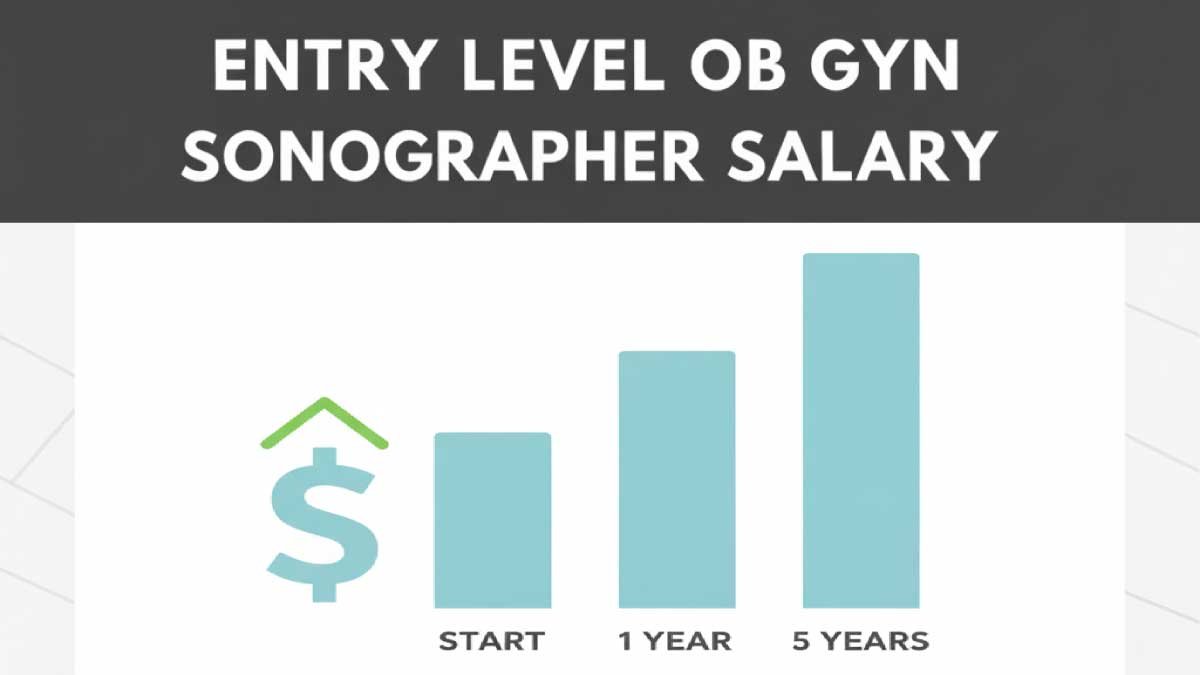Starting a career in diagnostic medical sonography can be exciting, especially if you’re passionate about women’s health. One of the most rewarding specialties is OB GYN sonography, where professionals use ultrasound imaging to help monitor pregnancies, assess reproductive health, and assist physicians in critical diagnoses.
As a beginner, the most common question is: What can I expect to earn as an entry-level OB GYN sonographer in 2025? This guide explores salary insights, pay ranges, influencing factors, comparisons with other specialties, career growth, and the overall benefits of entering this field today.
What Does an OB GYN Sonographer Do?
OB GYN sonographers specialize in imaging related to the female reproductive system and pregnancy. Unlike general sonographers who handle multiple types of imaging, OB GYN sonographers dedicate their practice to obstetric and gynecologic patients.
Daily Responsibilities Include:
-
Conducting ultrasound scans during different stages of pregnancy.
-
Identifying potential complications like ectopic pregnancies or fetal abnormalities.
-
Examining the uterus, ovaries, and reproductive system for gynecological health.
-
Documenting and presenting imaging results for physicians.
-
Supporting doctors during prenatal screening and specialized procedures.
The role is highly impactful, requiring strong technical knowledge and emotional intelligence. Because of this unique skillset, even entry-level salaries are competitive, making the career financially stable from the start.
Entry-Level OB GYN Sonographer Salary in 2025
In 2025, salaries for new OB GYN sonographers reflect increasing demand, inflation-adjusted pay, and the growing importance of women’s healthcare. Entry-level pay varies by employer type, location, and certification, but the overall range is strong.
Salary Breakdown Chart:
| Pay Type | Lower Range (USD) | Upper Range (USD) |
|---|---|---|
| Hourly | $28 | $36 |
| Monthly | $4,600 | $6,200 |
| Yearly | $56,000 | $74,000 |
This shows that new professionals entering the workforce in 2025 can expect a stable income starting at around $56,000 annually, with opportunities to move closer to $74,000 depending on employer and location.
For students or recent graduates, this salary range highlights the value of investing in a sonography degree or certificate program. Compared to many other entry-level healthcare roles, OB GYN sonographers start strong.
Factors That Influence Entry-Level Salary
Not all entry-level salaries are identical. Several factors determine where a new OB GYN sonographer will fall within the pay range.
1. Location
Geography plays one of the largest roles in salary differences.
High-paying states: California, New York, Washington, and Massachusetts often push entry-level salaries toward the $70,000+ mark.
Moderate-paying states: Texas, Illinois, and Florida fall in the mid-range.
Lower-paying areas: Some rural regions or smaller healthcare systems may start salaries closer to $55,000, but often the cost of living is lower in these areas.
2. Employer Type
The work setting also impacts salary.
Hospitals: Larger budgets and higher patient volumes typically mean higher pay, along with extra benefits like overtime and shift differentials.
Private Practices: OB GYN-focused clinics may offer stable work hours but sometimes slightly lower base pay.
Specialty Women’s Health Clinics: Competitive pay, especially in major cities where demand is high.
3. Certifications and Education
Earning credentials such as the ARDMS OB GYN specialty certification can boost entry-level salaries. Employers often prefer certified candidates because it demonstrates readiness, reducing training time.
4. Work Shifts
Some employers offer shift differentials, extra pay for working evenings, nights, or weekends. Entry-level sonographers willing to accept less desirable shifts often see faster salary growth.
Comparing OB GYN Sonographer Salary with Other Specialties
To understand how competitive OB GYN salaries are, it’s useful to compare them with other sonography specialties.
Salary Comparison Chart:
| Specialization | Average Entry-Level Yearly Salary (USD) |
|---|---|
| General Sonography | $52,000 – $68,000 |
| Cardiac Sonography | $55,000 – $72,000 |
| OB GYN Sonography | $56,000 – $74,000 |
| Vascular Sonography | $54,000 – $70,000 |
This comparison shows that OB GYN sonographers start on the higher end of the spectrum. The demand for pregnancy monitoring, fertility treatments, and women’s health imaging drives consistent need, giving this specialization an advantage over some others.
Salary Growth Beyond Entry-Level
While the entry-level pay is already strong, OB GYN sonographers benefit from steady salary growth as they gain experience.
2–3 Years of Experience: Salaries often increase to $65,000 – $85,000 annually, especially with added certifications.
5+ Years of Experience: Experienced OB GYN sonographers earn $75,000 – $95,000 annually depending on employer and region.
Supervisory or Senior Roles: Lead sonographers, department managers, or educators can exceed $100,000 annually in some states.
This growth reflects both the technical expertise gained over time and the shortage of skilled ultrasound professionals across the country.
Real-Life Career Example
Consider Maria, who graduated from a diagnostic medical sonography program in 2024 with an OB GYN focus. She began working in a women’s health clinic in Arizona in early 2025, starting with a salary of $58,000 annually. Within two years, Maria earned her ARDMS certification and transitioned to a hospital role, raising her salary to $72,000.
Her story reflects a common path: starting in a smaller clinic, gaining hands-on experience, and then leveraging certification and relocation for higher pay.
Benefits Beyond Salary
When evaluating an OB GYN sonographer career, it’s important to look at the total compensation package, not just the paycheck. Employers typically offer:
Health Coverage: Comprehensive medical, dental, and vision benefits.
Retirement Savings: 401(k) plans with employer matching contributions.
Paid Leave: Vacation days, sick time, and paid holidays.
Continuing Education: Many facilities cover costs for additional certifications or workshops.
These benefits can add the equivalent of several thousand dollars in value each year, making the career even more appealing to new graduates.
Challenges for Entry-Level OB GYN Sonographers
Every career has challenges, and OB GYN sonography is no exception.
Emotional Pressure: Working with expectant mothers brings joy, but it can also involve stressful situations when complications arise.
Physical Demands: Long hours standing, scanning, and repetitive wrist motions can be physically tiring.
Adjustment Period: Entry-level professionals must quickly learn to handle independent decision-making and patient interactions.
These challenges are balanced by the satisfaction of supporting women’s health and playing a crucial role in prenatal care.
Future Outlook for OB GYN Sonographers
The future remains bright for OB GYN sonographers in 2025 and beyond. Demand for reproductive health and prenatal imaging is expected to keep growing due to:
-
Rising birth rates in certain regions.
-
Greater reliance on advanced imaging for fertility treatments.
-
Expansion of healthcare services in women’s health clinics.
The Bureau of Labor Statistics projects sonography as one of the fastest-growing healthcare careers. For entry-level OB GYN sonographers, this means continued job security and salary increases over the next decade.
Long-Term Career Outlook for OB GYN Sonographers
One of the biggest advantages of entering this field in 2025 is its long-term stability. Unlike some careers that fluctuate with economic cycles, healthcare—especially women’s health—remains essential. As technology continues to improve, ultrasound imaging is becoming more advanced, making OB GYN sonographers even more valuable.
By 2030, experts predict the need for OB GYN sonographers will increase by at least 14–17%, which is faster than the average for all occupations. This means that not only will salaries continue to rise, but job security will remain strong. Hospitals and clinics will compete for skilled sonographers, giving professionals the flexibility to negotiate better pay, choose preferred shifts, or explore roles in specialized clinics.
Specialization and Advanced Roles
Starting as an entry-level OB GYN sonographer is only the beginning. With time and continued education, professionals can expand into advanced roles such as:
Maternal-Fetal Medicine Sonographer: Assisting in high-risk pregnancies and advanced fetal diagnostics.
Lead or Supervisory Sonographer: Overseeing teams and managing imaging departments.
Educator or Trainer: Teaching future sonographers at colleges and universities.
Travel Sonographer: Taking short-term contracts nationwide, often with higher pay and additional perks.
Each of these pathways offers salary increases well above the entry-level range. Some advanced roles easily cross the $100,000 per year threshold, making it a lucrative long-term career.
Why 2025 Is the Best Year to Begin
Healthcare facilities are currently experiencing staffing shortages in diagnostic imaging. For new graduates, this creates a perfect opportunity: employers are willing to offer competitive salaries, sign-on bonuses, and strong benefit packages to attract entry-level OB GYN sonographers.
If you are just starting your career in 2025, you are entering the market at a time when demand is high, salaries are strong, and opportunities for growth are plentiful. This combination makes OB GYN sonography one of the most secure and rewarding healthcare careers available today.
Also Read:
Conclusion
Starting as an entry-level OB GYN sonographer in 2025 offers both financial stability and career growth opportunities. With salaries ranging from $56,000 to $74,000 annually, new professionals begin their careers on strong financial footing. Factors like location, certification, and employer type can influence pay, but the overall outlook is highly positive.
Beyond salary, OB GYN sonographers enjoy excellent benefits, job satisfaction, and clear opportunities for advancement into senior roles. While the role presents challenges, the rewards of supporting women’s health make it a fulfilling choice.
For students and new graduates entering the field in 2025, the journey is just beginning—and the career path promises both financial and professional growth.
FAQs:
What is the average entry-level OB GYN sonographer salary in 2025?
In 2025, the average entry-level OB GYN sonographer salary ranges from $56,000 to $74,000 per year. This amount may differ based on location, employer type, and certifications. New graduates typically start near the lower end but can quickly progress with additional skills and professional credentials.
Do OB GYN sonographers earn more in hospitals or clinics?
Hospitals usually pay higher entry-level salaries compared to private practices or small clinics. However, clinics often offer more predictable schedules and work-life balance. Larger women’s health centers or specialty OB GYN facilities may pay competitively as well, especially in urban areas where patient demand is strong and healthcare budgets are larger.
How much do entry-level OB GYN sonographers earn hourly?
Entry-level OB GYN sonographers in 2025 earn between $28 and $36 per hour. The hourly rate depends on employer type, region, and work shifts. Those working nights or weekends may earn additional pay differentials. Over time, hourly wages increase steadily as professionals gain more hands-on experience in women’s healthcare imaging.
Which states offer the highest salaries for OB GYN sonographers?
States such as California, New York, Massachusetts, and Washington generally provide the highest entry-level salaries, often reaching or exceeding $70,000 per year. These regions have strong healthcare systems and high patient demand, but they also come with higher living costs. Rural states may pay less, though overall expenses tend to be lower.
Can certifications increase an entry-level salary?
Yes, holding certifications like the ARDMS OB GYN specialty credential often raises entry-level salaries. Employers value certified candidates because they require less supervision and bring proven skills. Certification not only increases starting pay but also helps sonographers stand out in competitive job markets, opening doors to better positions and faster career growth.
What benefits do entry-level OB GYN sonographers usually receive?
In addition to salary, most entry-level OB GYN sonographers receive benefits such as health insurance, retirement plans, paid time off, and continuing education support. Some employers also offer sign-on bonuses or shift differentials. These benefits significantly increase the total compensation value, making the profession more financially rewarding beyond just base salary numbers.
Is the demand for OB GYN sonographers expected to grow?
Yes, demand is steadily increasing due to population growth, fertility treatments, and advanced prenatal care. The field of diagnostic medical sonography is projected to grow faster than average through 2030. Entry-level OB GYN sonographers entering in 2025 will likely find excellent job opportunities, competitive salaries, and long-term career security across multiple healthcare settings.

